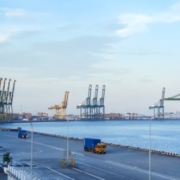Singapore reopens defunct container terminals to tackle vessel bunching
Authorities battling congestion in Singapore port have reopened shuttered terminals to alleviate the mounting pressure on the world’s largest transhipment hub.
The Maritime & Port Authority of Singapore (MPA) yesterday announced that port operator PSA had “reactivated older berths and yards that have previously been decanted at Keppel Terminal”, which has upped the port’s weekly handling capacity from 770,000 teu to 820,000.
It said although box volumes in the port over the first four months of 2024 had grown 8.8% year on year, to 13.36m teu, the problems had largely been caused by carriers seeking to play catch-up in their schedules at Singapore.
“We have seen large increases in container volumes and the “bunching” of container vessel arrivals over the previous months, due to supply chain disruptions in upstream locations,” said the MPA.
“The increase in container vessels arriving off-schedule and the increased container volumes handled resulted in longer vessels’ wait time for a container berth.”
It added: “The increased demand on container handling in Singapore is a result of several container lines discharging more containers as they forgo subsequent voyages to catch up on their next schedules. The number of containers handled per vessel has also increased.”
According to the eeSea liner database, there are currently 47 box vessels waiting for a berth at Singapore, and 53 undergoing cargo operations.
Meanwhile, new schedule reliability data released by Sea-Intelligence today says global schedule reliability has fallen to just over 50%, compared with around 65% at this point last year.
The interlocking dynamics of port congestion and deteriorating liner schedules appear to be acting like a fast-spreading infection, with carriers and forwarders trying to recoup the costs of moving containers through busy ports and severely delayed vessels.
The Loadstar receives reports of schedule delays, port omissions and equipment shortages on a daily basis.
Here’s one example from Dubai-headquartered NVOCC CargoGulf of its daily schedule update for just one of the vessels in its AGA service:
“Vessel is undergoing cargo ops at JEA ETD 30 May (port stay of approx 89hrs). Vessel badly delayed due to NGB port closure / SHA/SHK congestion. Simulated 48 hrs berth delay at CMB due to berth congestion (and heavy monsoon winds/rain). SIN e/b will omit due to 5-7 days’ congestion.”
As a result, CargoGulf commercial manager Hans-Henrik Nielsen told The Loadstar it had been forced to implement a $200 port congestion surcharge on all westbound services from tomorrow (1 June).
“As you can deduce from the above, every port in the pro forma schedule faces significant delays. You can pretty much allow 8-10 days delay in a normal 35-day round-trip.
“It also results in severe “bunching” of vessels. So, instead of a nice weekly frequency, we end up with three vessels in eight days – difficult for both shippers and us,” he explained.
The Q1 Schedule Reliability Scorecard, published by liner database eeSea this week, included an insight into how bunching and delays ripple across a service.
Breaking down the vessel arrivals on THE Alliance’s transpacific TP4 service, it is effectively a postmortem of schedule disruption, demonstrating how delays increase in magnitude over the course of several rotations.
Even after the initial service calls, port congestion in China has meant vessels routinely arriving at the first North American port up to four days late, and often another 20 days late returning to Asia.
“Ports further down the rotation take the brunt of the hit,” noted eeSea. “The window of standard deviation grows progressively wider and increases in minimum delay, as do the frequency of extreme outliers, perfectly illustrating the ‘ripple’ effect of cumulative delay.”
The transpacific and Asia-Middle East may be different trades, but they face identical issues and Mr Nielsen explained how the bunching affected supply chains at an operational level.
“The extra cost is significant, and our equipment management is out the window – it’s impossible to get boxes to the right place at the right time.
“With the omittance of port calls, we also lose revenue. Bottom line – much higher cost and less revenue. Not the best combination for any business…”
And his message to carriers’ customers was to take every ETA with a large grain of salt.
“By now, there should not be a forwarder or importer unaware of this “across the board” situation – do not plan, promise or expect ‘just in time’.
“It’s more likely to snow in Dubai in June!” he said.
NEWS FROM: https://theloadstar.com/singapore-reopens-defunct-container-terminals-to-tackle-vessel-bunching/






